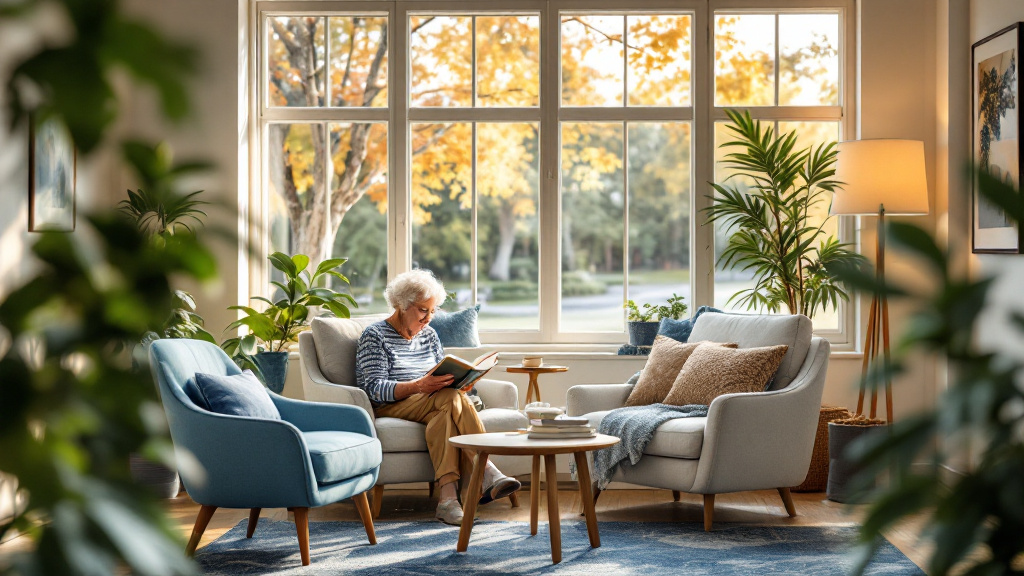
Vibrant Social Activities in Assisted Living
March 4, 2025
Explore engaging social activities and events in assisted living, promoting connection and vibrant community life.
Social Activities in Assisted Living

Importance of Social Engagement
Social engagement is a vital aspect of life in assisted living facilities, as it significantly impacts both physical and mental health for seniors. Assisted living communities prioritize social interactions among residents, facilitating a variety of activities and settings that foster meaningful connections. According to Eden Senior Care, socialization helps reduce feelings of isolation and loneliness, which are common issues among older adults.
Participating in social activities not only enhances emotional well-being but also supports cognitive function. Engaging with peers in activities like board games, group exercises, and special events promotes teamwork and cooperation, helping seniors build lasting friendships. The benefits of social engagement extend to the overall quality of life, as residents experience a renewed sense of purpose and fulfillment.
Benefits of Social Activities
Social activities in assisted living facilities offer numerous benefits that contribute to residents' overall health and happiness. These activities can include organized events, outings, and casual gatherings, all of which are designed to foster engagement and community building.
Benefits of Social ActivitiesDescriptionCognitive StimulationEngaging in mentally stimulating activities helps promote cognitive health and may lower the risk of cognitive decline.Emotional SupportSocial interactions provide emotional reassurance, helping residents feel connected and supported in their new environment.Physical HealthActivities that encourage movement, such as group exercises, enhance physical health and improve mobility.Sense of CommunityRegular socialization fosters a strong sense of belonging, enhancing satisfaction with life in assisted living.Reduction of LonelinessMeaningful engagement with others helps alleviate feelings of isolation, which are increasingly common among seniors.
Social activities can range from simple game nights to larger community events. Each activity serves not only as a source of enjoyment but also as a means to build relationships among residents. Engaging in these activities reinforces the principles of how assisted living promotes cognitive health and supports mental health in older adults. For more insights on enhancing connections and combating loneliness, refer to our article on how to stay socially connected in assisted living.
Holiday Celebrations in Senior Living

Community Bonding through Holidays
Holiday celebrations in senior living communities are essential for nurturing social connections among residents. These events provide opportunities for individuals to socialize, create lasting memories, and foster a sense of belonging. Celebrating milestones and traditions helps combat loneliness and isolation, common feelings among residents.
By organizing themed activities such as decorating, crafting, and baking, communities can bring joy and a sense of purpose to the residents. These activities not only create a festive atmosphere but also encourage camaraderie and teamwork, significantly enhancing the community spirit.
Activity TypeSocial BenefitDecoratingEnhances team spiritCraftingFosters creativityBakingCreates shared experiences
Family involvement is also encouraged during holiday festivities, facilitating visits that strengthen bonds and promote unity. Proactive measures, such as easing visiting policies and scheduling designated family days, enhance the communal atmosphere during these special occasions.
Incorporating Traditions and Menus
Incorporating traditions and special menus during holiday celebrations adds a sense of nostalgia and inclusivity to the festivities. Holiday-themed meals cater to residents' preferences and dietary needs while invoking cherished memories. Traditional dishes can create a comforting environment, fostering cultural appreciation and inclusiveness [1].
Creating a menu that accommodates individual needs is vital. Special attention should be given to dietary restrictions, mobility challenges, and sensory sensitivities to ensure that every resident can fully enjoy the holiday celebrations.
HolidayTraditional DishDietary ConsiderationsThanksgivingRoast TurkeyGluten-free options availableChristmasGingerbread CookiesSugar-free options availableNew YearBlack-Eyed PeasLow-sodium options
Creating a comfortable environment where residents feel included and appreciated enhances the overall experience of holiday celebrations in senior living. These gatherings serve not only to celebrate but also to strengthen the sense of community, making them a pivotal aspect of resident life. For further information about engaging community events, check our resources on social activities and events in assisted living.
Daily Activities in Assisted Living

In assisted living facilities, daily activities play a crucial role in promoting social engagement, enhancing the quality of life for older adults. These structured activities not only encourage interaction among residents but also foster a sense of community and belonging.
Group Exercises and Art Sessions
Group exercises are a popular choice in assisted living communities, providing both physical benefits and opportunities for social interaction. These exercise sessions may include activities such as chair yoga, stretching, or walking clubs. Regular participation in group fitness stimulates physical health, enhances mobility, and can also improve mental well-being. Engaging in physical activities within a group setting encourages camaraderie and motivation among residents.
Art sessions are another valuable daily activity that can significantly impact the emotional and cognitive health of seniors. These sessions often include painting, crafting, or even adult coloring activities, allowing residents to express themselves creatively. Participating in art can reduce feelings of loneliness and anxiety, helping to improve overall mental health. For more on enhancing mental wellness in older adults, explore our article on how to improve mental health in elderly.
Activity TypeBenefitsGroup ExercisesImproves physical health, enhances mobility, fosters social interactionArt SessionsEncourages creative expression, alleviates anxiety, improves cognitive health
Game Nights and Movie Screenings
Game nights are another essential activity in assisted living facilities, providing residents with opportunities to engage in friendly competition and social bonding. Activities such as bingo, card games, and board games foster teamwork, cooperation, and friendships. Engaging in such social activities can significantly enhance emotional well-being and strengthen social connections among residents [2].
Movie screenings also add to the variety of daily activities offered in assisted living. These events can be enriching experiences, often accompanied by discussions about the film, encouraging residents to share their thoughts and feelings. Movie nights create an opportunity for entertainment and relaxation, contributing to a vibrant community atmosphere. To learn more about the benefits of social engagement in senior living, consider reading our article on how assisted living supports senior mental wellness.
Activity TypeBenefitsGame NightsPromotes social interaction, teamwork, and cooperationMovie ScreeningsProvides entertainment, encourages discussion, fosters community bonding
Through these daily activities, assisted living facilities can significantly enhance the lives of their residents, ensuring a fulfilling and socially engaging environment. Engaging in social activities and events in assisted living contributes positively to older adults' quality of life, cognitive function, and overall happiness.
Enhancing Social Bonds
Strengthening social ties within assisted living communities is essential for fostering a sense of belonging and improving overall well-being. Special events, celebrations, outdoor excursions, and the integration of technology play significant roles in enhancing these social bonds.
Special Events and Celebrations
Holidays, birthdays, and themed parties are pivotal elements of social activities and events in assisted living. These occasions provide opportunities for residents to come together, share stories, and create lasting memories. The inclusion of special holiday menus and traditional dishes caters to residents' preferences and dietary needs, invoking nostalgia and fostering cultural appreciation [1].
The key benefits of special events and celebrations include:
BenefitsDescriptionCommunity EngagementResidents connect over shared experiences and traditions.Emotional Well-beingCelebrating milestones contributes to happiness and life satisfaction.Strengthened RelationshipsFamily visits are encouraged, enhancing bonds between residents and their loved ones [1].
Through these gatherings, assisted living facilities can promote a sense of community spirit among residents, ultimately enriching their quality of life [2].
Outdoor Excursions and Technology
Outdoor excursions can significantly enhance residents' connection to the broader community. These activities provide a change of scenery and a sense of adventure, which is often missing within the walls of the facility [2]. Whether it's a trip to a local park or a visit to a cultural site, these excursions allow seniors to engage with the outside world, which can increase social interaction and overall happiness.
Alongside outdoor activities, the integration of technology offers innovative ways to enhance resident engagement. Technological tools provide cognitive stimulation and facilitate communication with loved ones. This connection is vital for emotional well-being and can lead to improved quality of life overall [2].
Using technology can include activities such as video calls, virtual games, or online classes, helping residents not only stay entertained but also socially connected. For tips on maintaining social connections in assisted living, refer to our article on how to stay socially connected in assisted living.
In summary, special events and outdoor excursions, along with the use of technology, are essential components for enhancing social bonds in assisted living communities. This multifaceted approach contributes positively to the emotional and social well-being of residents.
Engaging Nursing Home Residents
Engaging nursing home residents through meaningful activities is essential for enhancing their quality of life. This section emphasizes the importance of person-centered activity programs and the need to assess resident needs effectively.
Person-Centered Activity Programs
Person-centered activity programs are designed to cater to the interests, hobbies, and personal histories of residents. This individualized approach allows caregivers to create activities that resonate with each resident, promoting enjoyment and engagement. According to Care365, incorporating person-centered care in activity planning is crucial. Residents feel empowered when they have a voice in decisions regarding their activities, fostering a sense of control and purpose.
Some common activities that may be included in person-centered programs include:
Activity TypeDescriptionArts and CraftsEngaging residents in creative projects that align with their skills and preferences.Music TherapyUtilizing music to stimulate memories and encourage participation.GardeningActivating residents' connection to nature through planting and caring for plants.Reminiscing SessionsFostering discussions about past experiences to enhance emotional well-being.
These activities not only enhance emotional well-being but also contribute positively to cognitive function and independence.
Assessing Resident Needs
Assessing the needs and preferences of nursing home residents is vital for designing engaging social activities and events in assisted living. Caregivers should take time to understand each resident's individual interests and capabilities. This knowledge aids in tailoring activities that are both meaningful and enjoyable.
Engaging residents in this assessment process can also be beneficial. Options such as surveys or informal conversations can provide insights into their interests. Engaging nursing home residents in their care and activity planning enhances their emotional well-being, cognitive function, and self-image, as emphasized in research by Care365.
By focusing on individual preferences and continuously assessing resident needs, caregivers can foster connections and alleviate feelings of loneliness. This allows for a more fulfilling and enriched life within the community.
Further information on how to improve mental well-being in elderly populations can be found in our article on how to improve mental health in elderly and resources on mental health support in assisted living.
Family Involvement in Senior Care
Involving family members in senior care is essential for enriching the lives of residents in assisted living facilities. Family visits and connections have a significant impact on the emotional and mental well-being of residents, promoting a sense of community and belonging.
Importance of Family Visits
Family visits are not just social gatherings; they play a crucial role in ensuring the emotional health of residents. These interactions foster togetherness during moments like holiday celebrations, strengthening bonds between residents and their loved ones. Studies indicate that increased family involvement can lead to several positive outcomes, including:
OutcomeEffectLife SatisfactionHigher levels reportedPsychosocial ImpairmentLower rates among residentsMortalityDecreased risk observedInfections and HospitalizationsLower incidence linked to family support
These outcomes highlight the transformative power of family involvement in enhancing the quality of life for seniors in assisted living environments.
Facilitating Family Connections
Facilitating family connections involves multi-dimensional aspects, such as visits, socioemotional support, and advocacy for residents [3]. Various factors can influence family involvement, including the geographic proximity of family members, the resident’s cognitive status, and previous contact before admission.
Programs like the Family Involvement in Care (FIC) aim to strengthen these relationships. The FIC program focuses on enhancing communication between family caregivers and facility staff, ensuring that family members are engaged in care planning and decisions. This model has led to better responses from residents during visits and reduced reliance on medications for those with dementia [3].
Ultimately, facilitating these connections is key to creating a supportive atmosphere that recognizes the valuable role families play in the lives of their loved ones in assisted living. Resources are available to help families stay connected and informed on how they can enhance their loved one's experience, such as tips for how to stay socially connected in assisted living and tips for making your assisted living space feel like home.
References
[2]:
[3]:


































































































